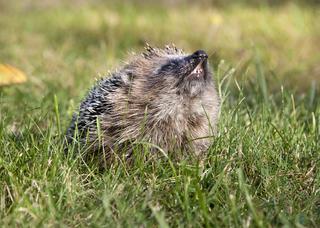Our official English website, www.x-mol.net, welcomes your
feedback! (Note: you will need to create a separate account there.)
Genetic structure of the European hedgehog (Erinaceus europaeus) in Denmark.
PLOS ONE ( IF 2.9 ) Pub Date : 2020-01-17 , DOI: 10.1371/journal.pone.0227205 Sophie Lund Rasmussen 1 , Jeppe Lund Nielsen 2 , Owen R Jones 1, 3 , Thomas B Berg 1, 4 , Cino Pertoldi 2, 5
PLOS ONE ( IF 2.9 ) Pub Date : 2020-01-17 , DOI: 10.1371/journal.pone.0227205 Sophie Lund Rasmussen 1 , Jeppe Lund Nielsen 2 , Owen R Jones 1, 3 , Thomas B Berg 1, 4 , Cino Pertoldi 2, 5
Affiliation

|
OBJECTIVES
Low genetic diversity can lead to reduced average fitness in a population or even extinction. Preserving genetic connectivity across fragmented landscapes is therefore vital to counteract the negative consequences of genetic drift and inbreeding. This study aimed to assess the genetic composition and consequently the conservation status of a nationwide sample of European hedgehogs (Erinaceus europaeus) in Denmark.
METHODS
We applied an adaptation of the genotyping by sequencing (GBS) technique to 178 individuals from six geographically distinct populations. We used a Bayesian clustering method to subdivide individuals into genetically distinct populations. We estimated individual observed (iHO), observed (HO), and unbiased expected (uHE) heterozygosity, inbreeding coefficient (FIS), percentage of polymorphic loci (P%) and tested for deviations from Hardy-Weinberg equilibrium (HWE). We used linear models to test for potential anthropogenic effects on the genetic variability of hedgehogs with iHO, uHE, P% and FIS as response variables, and assessed the demographic history of the population.
RESULTS
The Danish hedgehog population is composed of three genetic clusters. We found a mean P% of 54.44-94.71, a mean uHE of 0.126-0.318 and a mean HO of 0.124-0.293 in the six populations. The FIS was found to be significantly positive for three of the six populations. We detected a large heterogeneity of iHO values within populations, which can be due to inbreeding and/or fragmentation. FIS values decreased with increasing farmland density, but there was no significant association with human population or road density.
CONCLUSIONS
We found a low level of genetic variability and evidence for genetic substructure and low effective population size, which are all consequences of habitat fragmentation. We failed to detect signs of a recent population bottleneck or population increase or decline. However, because the test only identifies recent changes in population size, we cannot reject the possibility of a longer-term decline in the Danish hedgehog population.
中文翻译:

丹麦欧洲刺猬(Erinaceus europaeus)的遗传结构。
目标 遗传多样性低会导致种群平均适应度降低甚至灭绝。因此,在破碎的景观中保持遗传连通性对于抵消遗传漂变和近亲繁殖的负面影响至关重要。本研究旨在评估丹麦全国范围内的欧洲刺猬(Erinaceus europaeus)样本的遗传组成及其保护状况。方法 我们对来自 6 个不同地理群体的 178 名个体应用了测序基因分型 (GBS) 技术。我们使用贝叶斯聚类方法将个体细分为遗传上不同的群体。我们估计了个体观察到的 (iHO)、观察到的 (HO) 和无偏预期 (uHE) 杂合性、近交系数 (FIS)、多态位点百分比 (P%),并测试了哈迪-温伯格平衡 (HWE) 的偏差。我们使用线性模型来测试人为对刺猬遗传变异的潜在影响,以 iHO、uHE、P% 和 FIS 作为响应变量,并评估种群的人口统计历史。结果丹麦刺猬种群由三个遗传簇组成。我们发现这六个群体的平均 P% 为 54.44-94.71,平均 uHE 为 0.126-0.318,平均 HO 为 0.124-0.293。结果发现,六个人群中的三个人群的 FIS 呈显着阳性。我们检测到种群内 iHO 值存在很大的异质性,这可能是由于近亲繁殖和/或分裂造成的。 FIS 值随着农田密度的增加而降低,但与人口或道路密度没有显着相关性。 结论 我们发现遗传变异水平较低,并且有证据表明遗传亚结构和有效种群规模较低,这些都是栖息地破碎化的后果。我们未能发现近期人口瓶颈或人口增加或减少的迹象。然而,由于该测试仅确定了近期种群规模的变化,因此我们不能排除丹麦刺猬种群长期下降的可能性。
更新日期:2020-01-21
中文翻译:

丹麦欧洲刺猬(Erinaceus europaeus)的遗传结构。
目标 遗传多样性低会导致种群平均适应度降低甚至灭绝。因此,在破碎的景观中保持遗传连通性对于抵消遗传漂变和近亲繁殖的负面影响至关重要。本研究旨在评估丹麦全国范围内的欧洲刺猬(Erinaceus europaeus)样本的遗传组成及其保护状况。方法 我们对来自 6 个不同地理群体的 178 名个体应用了测序基因分型 (GBS) 技术。我们使用贝叶斯聚类方法将个体细分为遗传上不同的群体。我们估计了个体观察到的 (iHO)、观察到的 (HO) 和无偏预期 (uHE) 杂合性、近交系数 (FIS)、多态位点百分比 (P%),并测试了哈迪-温伯格平衡 (HWE) 的偏差。我们使用线性模型来测试人为对刺猬遗传变异的潜在影响,以 iHO、uHE、P% 和 FIS 作为响应变量,并评估种群的人口统计历史。结果丹麦刺猬种群由三个遗传簇组成。我们发现这六个群体的平均 P% 为 54.44-94.71,平均 uHE 为 0.126-0.318,平均 HO 为 0.124-0.293。结果发现,六个人群中的三个人群的 FIS 呈显着阳性。我们检测到种群内 iHO 值存在很大的异质性,这可能是由于近亲繁殖和/或分裂造成的。 FIS 值随着农田密度的增加而降低,但与人口或道路密度没有显着相关性。 结论 我们发现遗传变异水平较低,并且有证据表明遗传亚结构和有效种群规模较低,这些都是栖息地破碎化的后果。我们未能发现近期人口瓶颈或人口增加或减少的迹象。然而,由于该测试仅确定了近期种群规模的变化,因此我们不能排除丹麦刺猬种群长期下降的可能性。











































 京公网安备 11010802027423号
京公网安备 11010802027423号